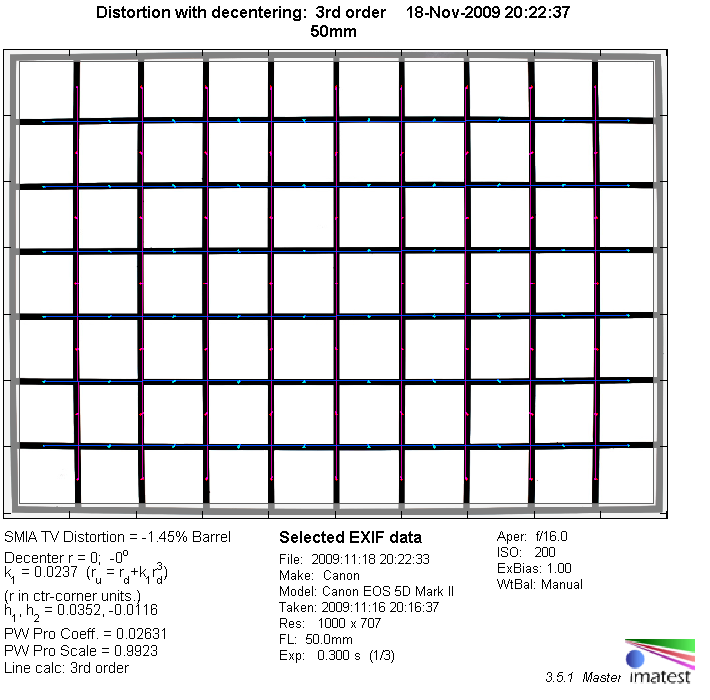|
Canon EF 50mm f/1.2 USM L (full format) - Review / Test Report - Analysis |
|
Lens Reviews -
Canon EOS (Full Format)
|
|
Page 2 of 3

Distortion
The EF 50mm f/1.2 USM L shows a moderate degree of barrel distortion (~1.5%) which can be visible in critical situations. This is slightly higher than average for a prime lens.

Note: the chart above has a real-world size of about 120x80cm.
Vignetting
Vignetting is a delicate topic for ultra-large aperture lenses used on full format DSLRs and, yes, the EF 50mm f/1.2 USM L has its share of problems here as well. At f/1.2 we're talking about more than 2.7EV - this is extreme and somewhat disappointing regarding the very large diameter of the front element. The situation does only marginally improve when stopping down to f/1.6 and it requires f/2 in order to reach acceptable levels here. The problem is basically negligible from about f/2.8 onwards.

MTF (resolution)
Technically the EF 50mm f/1.2 USM L is a mediocre performer with respect to its resolution characteristic. The center resolution is quite fine even at f/1.2 but the border quality is very poor till at least f/2. At f/2.8 the center quality is boosted to excellent levels whereas the border quality remains fairly low and you need to stop down to f/4 in order to achieve good quality results here. The peak performance is reached at f/5.6.
Please note that the quality of the lens is fine within the APS-C image circle and normally you will place your main subject within these limits.
All-in-all one of the weaker MTF curves that we've seen here. To be fair - the lens is simply designed to produce usable results at ultra large apertures and in this focal length class this is obviously only possible by compromising the peak performance. If you do not believe our findings here feel free to check the original Canon MTFs for this lens - they suggest a similar characteristic here.
Please note that the MTF results are not directly comparable across the different systems!
Below is a simplified summary of the formal findings. The chart shows line widths per picture height (LW/PH) which can be taken as a measure for sharpness.
If you want to know more about the MTF50 figures you may check out the corresponding Imatest Explanations

Lateral Chromatic Aberrations (CAs)
The EF 50mm f/1.2 USM L is quite prone to lateral chromatic aberrations (color shadows at harsh contrast transitions) - an average CA pixel width around 2px is unusually high for a prime lens.

Bokeh
The bokeh (the quality of the out-of-focus blur) is a primary aspect for an ultra large aperture lens. The EF 50mm f/1.2 USM L has a rather mixed characteristic here. In lab conditions we had no problems at all - out-of-focus highlights appear perfectly circular and uniform - this is about as good as it gets. The blur is also very smooth although it gets a bit more nervous in the transition zone as well as in the extreme corners.

The EF 50mm f/1.2 USM L is one of the few lenses which is capable of "melting" your scene - this was also apparent in our standard lab setup. Here's a sample crop which illustrates this "creamy" behavior @ f/1.2:
 The sharp hot spot in the sea of cream should be pretty obvious here. However, we do also need to mention an ugly side of the lens. The bokeh can get extremely nervous - here's sample border crop taken from one of the images in the sample image chapter (the park "gangway"). It seems as if this occurs primarily at the image borders in combination with a closer proximity to the sharp focus zone (the focus transition zone).
The sharp hot spot in the sea of cream should be pretty obvious here. However, we do also need to mention an ugly side of the lens. The bokeh can get extremely nervous - here's sample border crop taken from one of the images in the sample image chapter (the park "gangway"). It seems as if this occurs primarily at the image borders in combination with a closer proximity to the sharp focus zone (the focus transition zone).
 You may argue that this is a bit of an artificial setup in this sample image but simple imagine a person standing the focus zone and it's not all that abstract anymore. In any case the border bokeh is far from being pretty or in other words - it's ugly.
You may argue that this is a bit of an artificial setup in this sample image but simple imagine a person standing the focus zone and it's not all that abstract anymore. In any case the border bokeh is far from being pretty or in other words - it's ugly.
Bokeh Fringing / Longitudinal Chromatic Aberrations (LoCA)
Bokeh fringing is a common problem present in most large aperture lenses and the Canon lens is no exception to the rule here. If you look at the provided sample crops below you should be able to spot a purple halo in front of the focus zone and a green one beyond. This is clearly visible at f/1.2 till f/2. At f/2.8 the problem starts to fade and it's more or less resolved at f/4.
|
Move the mouse cursor over the f-stop marks below to observe the respective LoCAs
|
| f/1.2 |
f/1.6 |
f/2 |
f/2.7 |
|

|
|